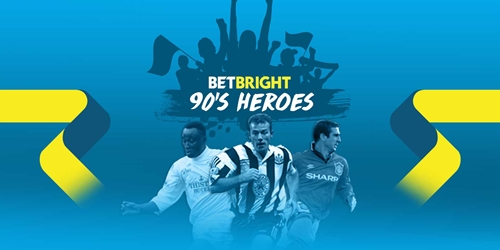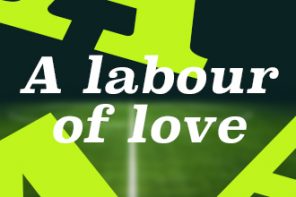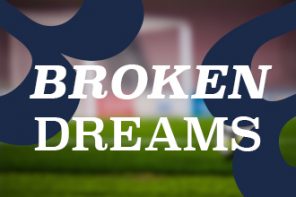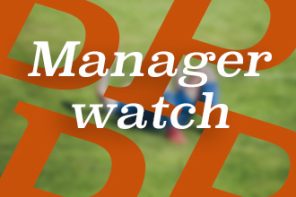’90s Heroes is a series by Adam Hurrey on the Bet Bright football blog which looks back on the legends of the game in what now seems a simpler time for football.
Duncan Ferguson; Jurgen Klinsmann; Faustino Asprilla; Juninho; Tony Yeboah; Georgi Kinkladze; David Ginola; Chris Waddle; Gianfranco Zola.
If it were in such a mood – and it frequently is – there would be plenty for a 90s-centric football blog to lament: the demise of Ceefax (p312, in particular), the Adidas Predator c.1998, Life of Riley being used to soundtrack the month’s best goals.
Rose-tinted tastes aside, the game has been arguably worse off since the tactical circle of life gradually killed off the strike partnership. There are, thankfully, rumblings of a rebirth here and there but we are now used to a sole, all-purpose spearhead being supported by pseudostrikers from out wide, jumped-up midfielders from deep or (the biggest victim in all of this, perhaps) the back-up goalscorer from the bench.
While the streamlining of forward lines has led to some delightfully stratospheric individual goal hauls in the last decade or so (sending the transfer values for those individuals on a similar trajectory) there is a charmless void left by the dovetailing duos of the 4-4-2/3-5-2 era. Yorke and Cole. Shearer and Sutton. Shearer and Sheringham. Shearer and Ferdinand.
Quinn and Phillips.
Firstly, it sounds better that way round – making it more like an 80s synthpop one-hit-wonder than a provincial butchers. It also acts as a handy flowchart for an attacking process – even if theirs wasn’t always as rigid as many assume – generally regarded as the “little and large”.
In the classic strike partnerships, goals are rarely shared equally. There is still a discernible hierarchy in place, which neatly mirrors the division of labour in the creation and conversion of anything up to 50 goals a season. Strike partnerships have their own lexicon – “turning provider”, “returning the favour” – not to mention the unmistakeable body language of the grateful goalscorer demonstrably recognising the assist by running over with a point of the finger.
Before their paths crossed in the North East with the considerable force of 185 goals in five seasons, Niall Quinn and Kevin Phillips had to find their feet elsewhere.
Quinn’s career had paused at plenty of curious crossroads before it reached Wearside. At home in Ireland, Gaelic football and, most notably, hurling called first – when this fairly ridiculous 40-yard first-time volley (!) suggested that association football wasn’t a clear first in the queue:
His array of sporting options didn’t stop there. Soon after being invited by Arsenal for a successful trial, Quinn was offered a four-year contract to play Australian Rules football for the Sydney Swans – and the money on offer to a 17-year-old was hard to ignore.
“Had it come before the Arsenal deal, I’d probably have taken it and gone to Sydney. I headed off to Arsenal but a year into it I wondered if I’d made the right call. For a long time I’d watch Australian Rules on television and wonder if I’d done the right thing.”
Those doubts may well have cropped up a few more times in the seven years at Highbury before, with first-team football high on Quinn’s agenda, he found a more accommodating club in Manchester City. His footballing education stepped up a gear, too: the goals came, so too did serious injury, but there were moments that Quinn’s all-round athleticism proved very useful. Against Derby in 1991, not satisfied with merely opening the scoring, Quinn then found himself pulling on a red-carded Tony Coton’s goalkeeping gloves to face a late penalty: the average football fan’s favourite possible scenario.
“I meet Dean Saunders the odd time and he had a great career and he always says to me ‘God, you ruined my career, Quinny’ because I saved his penalty. And they got relegated the same day.”
200-odd games, a decent goal return and a cruciate ligament injury later, Quinn again found himself pondering another pivotal career move. A move to Lisbon with Carlos Queiroz’s Sporting fell through at the last minute. That latest scene in the Sliding Doors backstory of Quinn and Phillips paved the way for the Irishman’s final switch. At 30, now hardened to the English game but still waiting for the chance to gather some goalscoring momentum, Quinn represented a good opportunity for newly-promoted Sunderland.
Another knee injury, however, put a four-month dent in his debut season – in his absence, nobody scored more than four in the Premier League and Sunderland were relegated.
13 – No player has scored more headed goals for Sunderland or Man City in the Premier League than Niall Quinn (13 for each club). Disco. pic.twitter.com/gctsyDu2SN
— OptaJoe (@OptaJoe) October 6, 2016
While his eventual strike partner’s career began with a wealth of options and ascended gradually from there, Kevin Phillips had to wait patiently to make a mark of any sort. Before Rickie Lambert’s beetroot-packing factory and Jamie Vardy’s Red Bull-powered non-league days, a 21-year-old Phillips was working in a bakery, in his ears still ringing the oldest rejection in the book: Southampton had told him he was too small to make it, certainly as a centre-forward. From dreaming of being the next Alan Shearer, Phillips was now turning out at right-back for Baldock Town in the Beazer Homes League – until an equally well-worn turn of events.
“We were struggling for a centre-forward one game and I put my hand up and said I’d have a go because that is what I always wanted to do. It was a lucky opportunity that came through injury – I played my first game, scored two goals and never looked back.”
Our next journeyman is non other than Kevin Phillips! Baldock Town to @watfordfcsays aged 21. #Superkev #Premlegend pic.twitter.com/trBTHYG2ON
— Future Elite Sports (@FutureEliteS) May 29, 2015
That lowly stroke of luck eventually led to Watford manager Glenn Roeder being persuaded to thrust Phillips into second-tier football. An initial £10,000 outlay would, within three unremarkable, injury-hit seasons at Vicarage Road, turn into a potential £600,000 windfall when Sunderland came calling. In keeping with Phillips winding road so far, though, it wasn’t clear cut. Peter Reid reportedly wanted to pair Quinn with his Ireland teammate – and Phillip’s Watford colleague – David Connolly. Dutch side Feyenoord irresistibly stepped in instead, and (thanks to Roeder’s prompting) Reid snapped up the still untested Phillips. A deadly strike partnership was – untidily, unwittingly – born.
The numbers happily speak for themselves. Those 185 goals they shared propelled Sunderland back to the Premier League at the second attempt – the first ran aground in a preposterous play-off final against Charlton in which Phillips was injured – and then twice in a row to the dizzying heights of seventh in the top flight, the club’s best finishes for nearly half a century.
In those four seasons, the names “Quinn” and “Phillips” appeared on the same scoresheet no fewer than 23 times. It was important for strike duos to gel, certainly, but it was crucial that they both scored goals. And Sunderland, somehow, had managed to usher both men to their professional peak.
17 years ago two Kevin Phillips goals sent Watford packing in #SAFC's first @PremierLeague game at the SoL pic.twitter.com/TeuR41e08u
— Sunderland AFC (@SunderlandAFC) August 10, 2016
Phillips’ patch was particularly purple. Sheer confidence was the hallmark of his finishing as he racked up 90 goals in three seasons but it was his 30 Premier League strikes in 1999/2000 that most perfectly showcased just how firmly in the zone Phillips was as he finally showed those youth coaches what they had missed. Quinn is the ideal spokesperson for his old partner’s repertoire that season, telling the Guardian recently:
“He scored every kind of goal. He scored volleys from outside the box; he scored a lot of headers; he could delicately pass it into the corner out of the reach of the keeper, then when it was on his left foot he could blast it. His favourite one was to bend it in the top-right corner.
“Once he got the ball out of his feet and on the move his accuracy was frightening really. There wasn’t a goal he couldn’t score.”
More to the point, there wasn’t a goal he wouldn’t dare score. On his way to the European Golden Shoe – sandwiching himself between vintage 1990s goal machines Mario Jardel and Henrik Larsson – two goals linger in the memory.
A wet Wednesday night at St James’ Park was the backdrop to Ruud Gullit’s nadir as Newcastle manager, misery compounded by Quinn and Phillips as the dropped Alan Shearer scowled in the home dugout. The big No.9’s glancing header cancelled out Newcastle’s opener just after the hour and, ten minutes later, the pint-sized No.10 helped himself:
17 years ago #SAFC notched a memorable win in apocalyptic conditions v #NUFC thanks Kevin Phillips + Niall Quinn. pic.twitter.com/JrSedg9Pp0
— Sunderland AFC (@SunderlandAFC) August 25, 2016
On first viewing, it seems like an audacious effort, but Phillips was far too businesslike for that. Having been briefly foiled by a sliding Tommy Wright in the deluge, Phillips simply swivelled round the ball to loft a finish into the unguarded far corner.
Reputations were royally disrespected elsewhere as Quinn (by now as close to unplayable as he would ever get) and Phillips (still making up for that lost time) experience their crowning moment as a goalscoring pair. Chelsea arrived at the Stadium of Light with one eye on the top of the table and another on the 4-0 demolition of Sunderland on the opening day of that season. Revenge was served, four-fold, within 38 minutes and a World Cup-winning defender barely knew what had hit him.
Marcel Desailly was a sprawling, wrong-footed mess at 1-0 (Quinn) and then a lumbering bystander for 2-0 and surely the defining goal out of Phillips’ 282.
Pedantry insists that we can’t call it a volley (nor even a half-volley), which is a crying shame. The Guardian’s Rob Smyth recently opted for “screamer” to describe it, and perhaps that as close as we can get. True, the ball does sit up very nicely off an aimless Chelsea boot – almost this-is-going-to-be-your-day nicely – but the rest is pure technique.
What no-one had noticed about Phillips until Baldock and the bakery is that he was a natural. “He is a phenomenal sporting guy,” says Quinn. “I remember going golfing with him one time. He hadn’t played in three years but still shot a 75 with a duff set of clubs. I played snooker with him and he gets a 50 break. He is a very special kind of fella.”
The increasingly beleaguered Desailly was then caught hopelessly under the ball from a lofted Sunderland cross, but Quinn had judged it perfectly to take the ball down and tease a save out of Ed de Goey, from which Phillips tucked in the rebound. In this case, at least, Desailly wasn’t the first or the last defender to be outwitted by Quinn under the high ball.
“[Aussie Rules] showed me how to lean into your opponent to get away from him to make yourself space rather than just leading for the ball. I used it to great effect in my whole career as a striker. I wasn’t the quickest, so I had to find ways to get to the ball first.”
The subtle chest-trap became just as potent a weapon for Quinn as his old-fashioned head, as he continued to read Sunderland’s endless conveyor belt of crosses from either wing better than his markers.
Desailly’s dreadful afternoon was complete with a desperate lunge on a rampant, first-half hat-trick-seeking Phillips, who had a shot tipped over by De Goey. From the corner, Quinn rifled home a left-foot volley. 4-0, Desailly was mercifully hooked at half-time, and Sunderland’s main men had earned hero status.
For all the surface-level promise of a little-and-large partnership, the combinations between Quinn and Phillips were less obvious than the slick dummies and runs of, say, Yorke and Cole. What the two lacked in training-ground drilling, they made up for with sheer football savvy.
“It was all instinctive, all intuitive,” Quinn recalls. “If you got in the same 5-a-side team as Kevin he wouldn’t pass the ball in training and you’d end up having a row with him. The reality was, we had simple enough ideas between us, he was great at reading things. I was the main target and he would be working off me. Generally, we had a little rule that if I was going up for a header, he would always feint to on the outside, move his man a yard and I would head it on the inside.”
While the big man gets all technical about it – Quinn is a good talker, as his post-playing days continue to attest – Phillips resorts to casual, reliable cliché:
“Niall knew what I was going to do and I read what he was going to do. Call it telepathy or whatever you like, we just clicked.”
But there was more to the partnership than simply Quinn flicking on and Phillips latching on: like any successful combo, they had their side projects. Whatever their pigeon holes implied, the 6ft 4in Quinn had the original Good Feet for a Big Man™…
…while the 5ft 7in Phillips – by now, absolutely not a right-back by trade – turned out to be a fine header of a ball after all:
Quinn and Phillips got the band together for one last show in Jody Craddock’s 2014 testimonial and, for once, it was Large who upstaged Little – even if Phillips couldn’t resist following up…
In more ways than one, Quinn and Phillips found themselves in the right place at the right time for the last hurrah of the Premier League strike partnership. If the two had coincided at the Stadium of Light 15 years later, would a Sunderland manager dare to start them together?
In 2016, you’d more than likely see Quinn kicking his heels on the bench, summoned only to bring on his kitchen sink for the last 10 minutes after your Duncan Watmores and Wahbi Khazris had failed to combine adequately with a lonely Phillips for the previous 80. The big man himself admits that ultra-modern tactics may not have been kind to him:
“If I got my chance again, with no support with Phillips or Robbie Keane around me, I think I’d have been back home on the next boat.”
For the next instalment of ’90s Heroes, check out the Bet Bright football blog on Friday.







